Clinical Governance and Practice Improvement
VerifiedAdded on 2023/01/07
|11
|2388
|66
AI Summary
This document discusses the need for change in clinical governance and practice improvement, focusing on dementia treatment. It explores the effectiveness of cognitive behavioral therapy in reducing anxiety and depression symptoms in elderly individuals. The document also highlights the research gaps in dementia prevention and the importance of multi-domain interventions. The research question and search strategy using the PICO framework are also discussed.
Contribute Materials
Your contribution can guide someone’s learning journey. Share your
documents today.
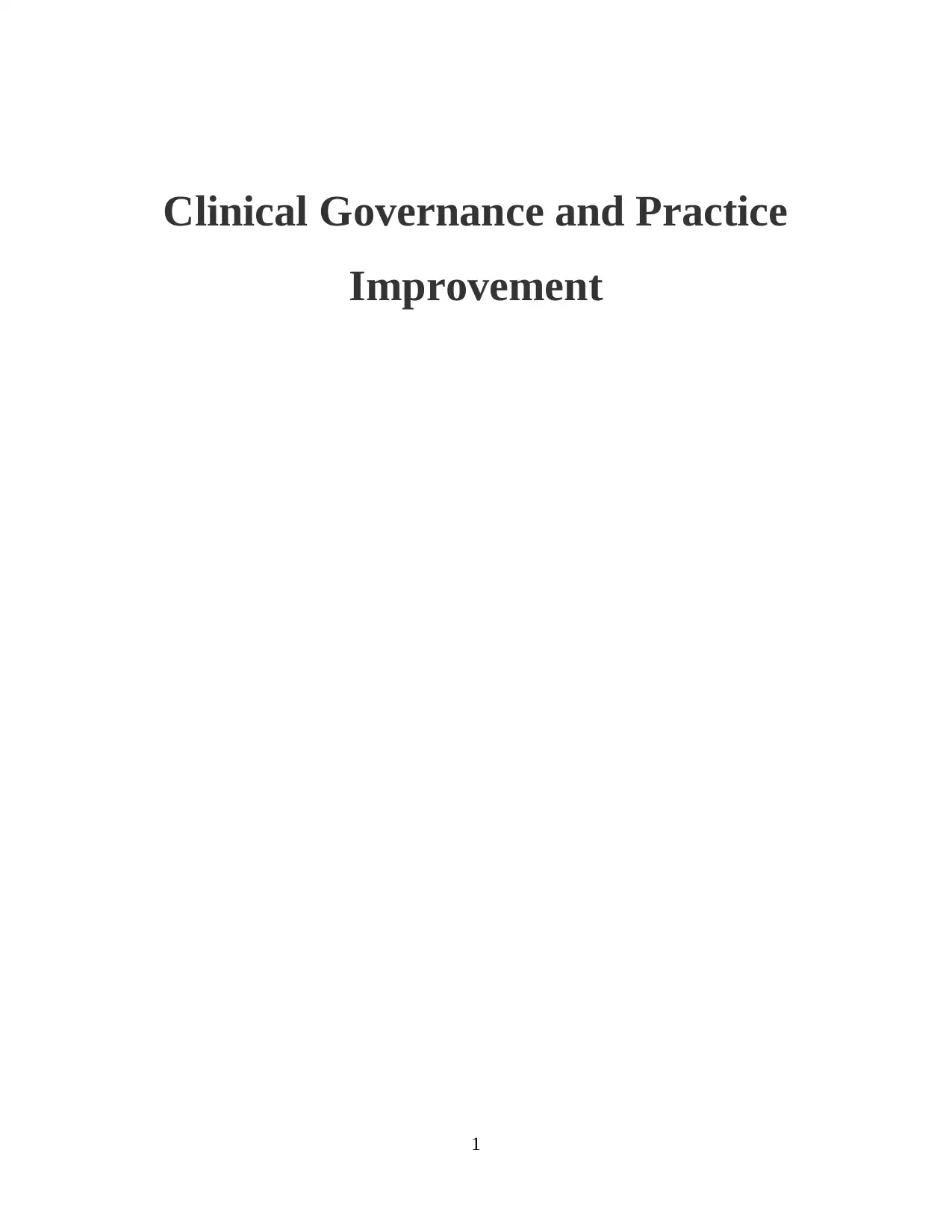
Clinical Governance and Practice
Improvement
1
Improvement
1
Secure Best Marks with AI Grader
Need help grading? Try our AI Grader for instant feedback on your assignments.
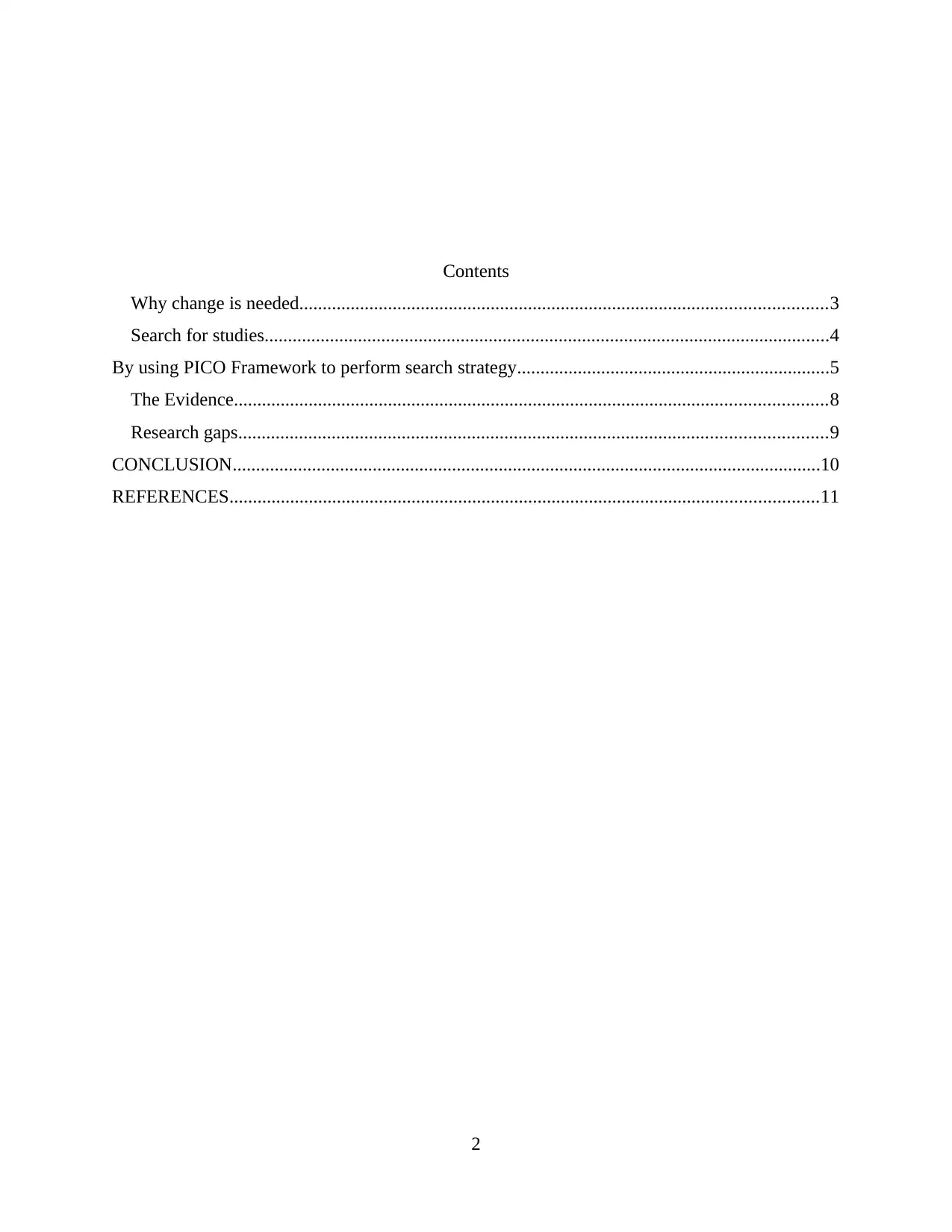
Contents
Why change is needed.................................................................................................................3
Search for studies.........................................................................................................................4
By using PICO Framework to perform search strategy...................................................................5
The Evidence...............................................................................................................................8
Research gaps..............................................................................................................................9
CONCLUSION..............................................................................................................................10
REFERENCES..............................................................................................................................11
2
Why change is needed.................................................................................................................3
Search for studies.........................................................................................................................4
By using PICO Framework to perform search strategy...................................................................5
The Evidence...............................................................................................................................8
Research gaps..............................................................................................................................9
CONCLUSION..............................................................................................................................10
REFERENCES..............................................................................................................................11
2
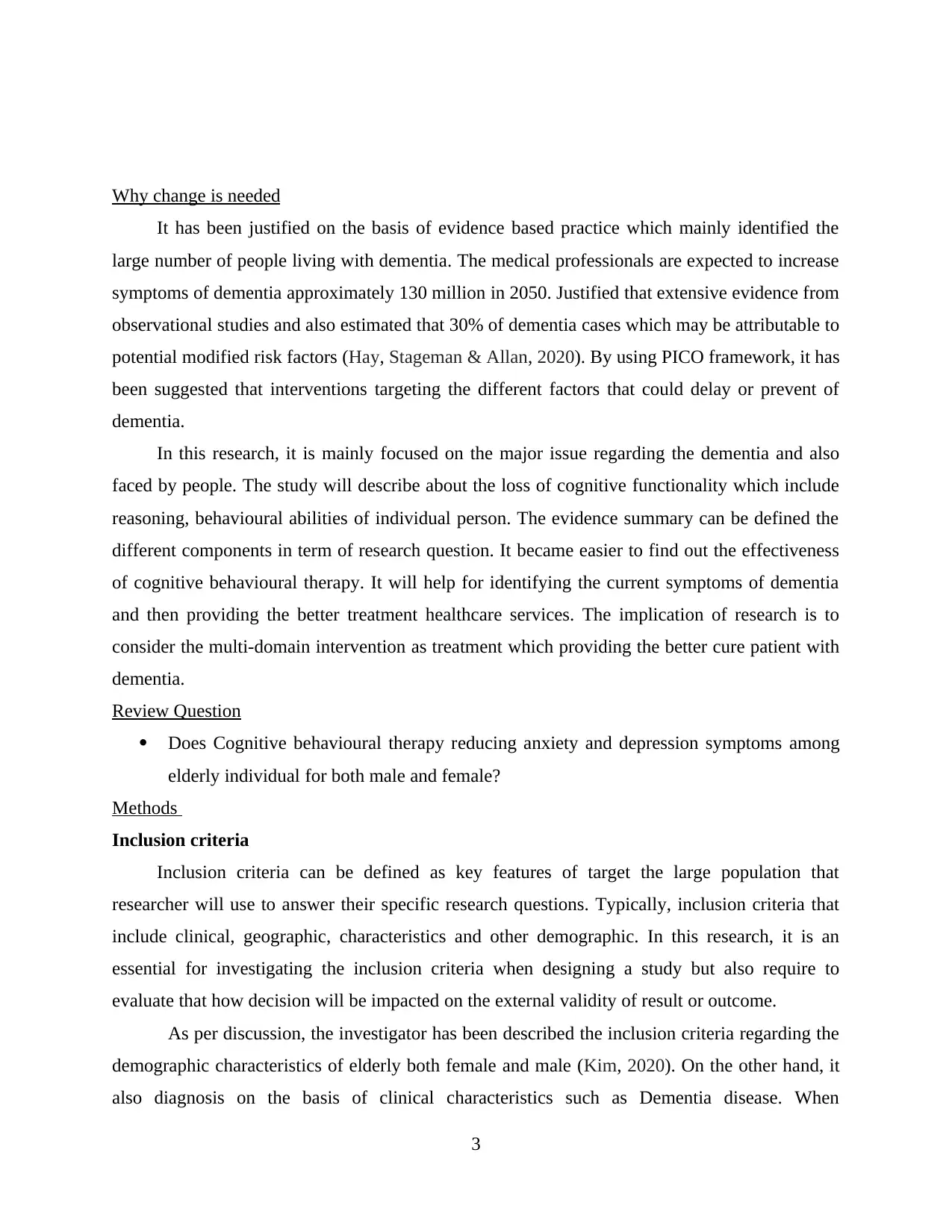
Why change is needed
It has been justified on the basis of evidence based practice which mainly identified the
large number of people living with dementia. The medical professionals are expected to increase
symptoms of dementia approximately 130 million in 2050. Justified that extensive evidence from
observational studies and also estimated that 30% of dementia cases which may be attributable to
potential modified risk factors (Hay, Stageman & Allan, 2020). By using PICO framework, it has
been suggested that interventions targeting the different factors that could delay or prevent of
dementia.
In this research, it is mainly focused on the major issue regarding the dementia and also
faced by people. The study will describe about the loss of cognitive functionality which include
reasoning, behavioural abilities of individual person. The evidence summary can be defined the
different components in term of research question. It became easier to find out the effectiveness
of cognitive behavioural therapy. It will help for identifying the current symptoms of dementia
and then providing the better treatment healthcare services. The implication of research is to
consider the multi-domain intervention as treatment which providing the better cure patient with
dementia.
Review Question
Does Cognitive behavioural therapy reducing anxiety and depression symptoms among
elderly individual for both male and female?
Methods
Inclusion criteria
Inclusion criteria can be defined as key features of target the large population that
researcher will use to answer their specific research questions. Typically, inclusion criteria that
include clinical, geographic, characteristics and other demographic. In this research, it is an
essential for investigating the inclusion criteria when designing a study but also require to
evaluate that how decision will be impacted on the external validity of result or outcome.
As per discussion, the investigator has been described the inclusion criteria regarding the
demographic characteristics of elderly both female and male (Kim, 2020). On the other hand, it
also diagnosis on the basis of clinical characteristics such as Dementia disease. When
3
It has been justified on the basis of evidence based practice which mainly identified the
large number of people living with dementia. The medical professionals are expected to increase
symptoms of dementia approximately 130 million in 2050. Justified that extensive evidence from
observational studies and also estimated that 30% of dementia cases which may be attributable to
potential modified risk factors (Hay, Stageman & Allan, 2020). By using PICO framework, it has
been suggested that interventions targeting the different factors that could delay or prevent of
dementia.
In this research, it is mainly focused on the major issue regarding the dementia and also
faced by people. The study will describe about the loss of cognitive functionality which include
reasoning, behavioural abilities of individual person. The evidence summary can be defined the
different components in term of research question. It became easier to find out the effectiveness
of cognitive behavioural therapy. It will help for identifying the current symptoms of dementia
and then providing the better treatment healthcare services. The implication of research is to
consider the multi-domain intervention as treatment which providing the better cure patient with
dementia.
Review Question
Does Cognitive behavioural therapy reducing anxiety and depression symptoms among
elderly individual for both male and female?
Methods
Inclusion criteria
Inclusion criteria can be defined as key features of target the large population that
researcher will use to answer their specific research questions. Typically, inclusion criteria that
include clinical, geographic, characteristics and other demographic. In this research, it is an
essential for investigating the inclusion criteria when designing a study but also require to
evaluate that how decision will be impacted on the external validity of result or outcome.
As per discussion, the investigator has been described the inclusion criteria regarding the
demographic characteristics of elderly both female and male (Kim, 2020). On the other hand, it
also diagnosis on the basis of clinical characteristics such as Dementia disease. When
3
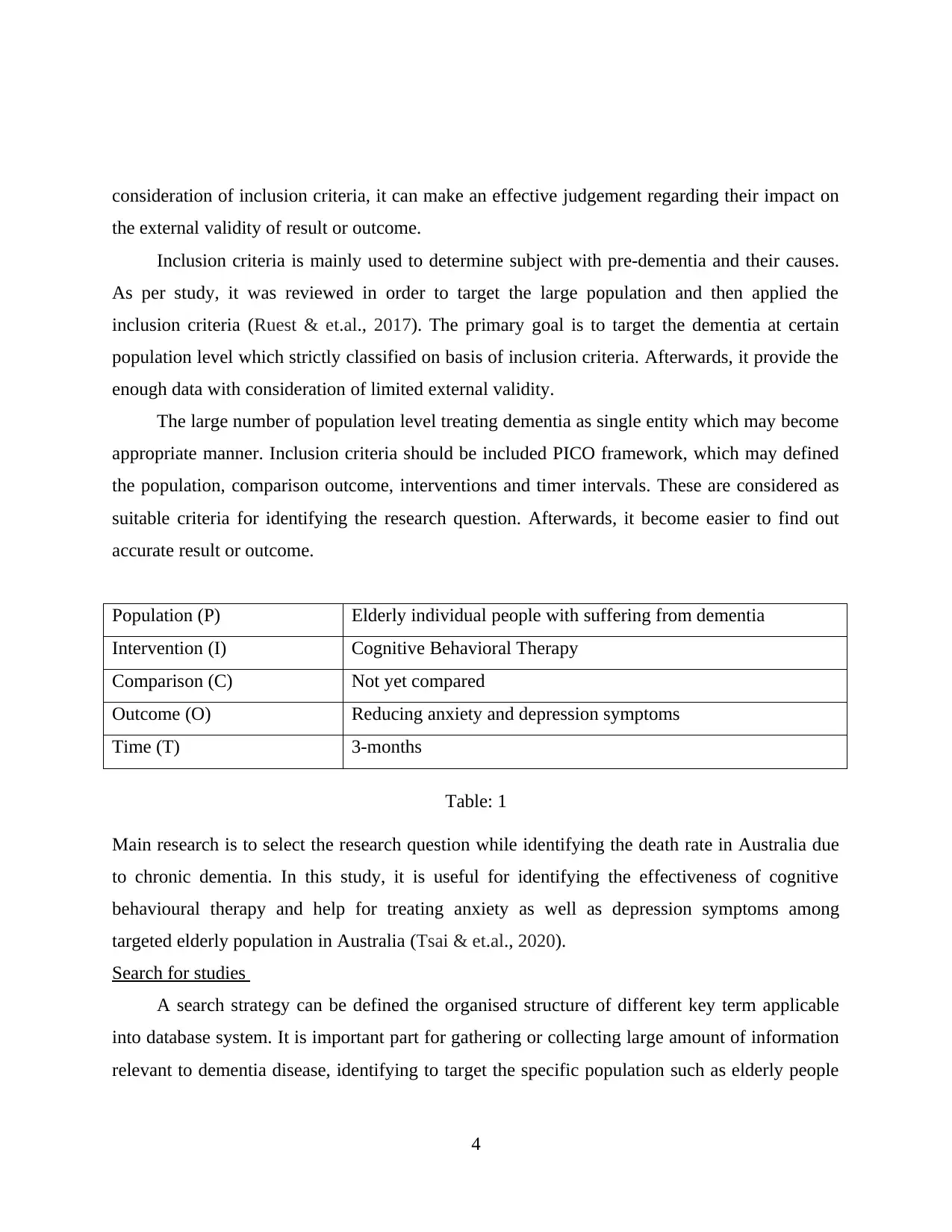
consideration of inclusion criteria, it can make an effective judgement regarding their impact on
the external validity of result or outcome.
Inclusion criteria is mainly used to determine subject with pre-dementia and their causes.
As per study, it was reviewed in order to target the large population and then applied the
inclusion criteria (Ruest & et.al., 2017). The primary goal is to target the dementia at certain
population level which strictly classified on basis of inclusion criteria. Afterwards, it provide the
enough data with consideration of limited external validity.
The large number of population level treating dementia as single entity which may become
appropriate manner. Inclusion criteria should be included PICO framework, which may defined
the population, comparison outcome, interventions and timer intervals. These are considered as
suitable criteria for identifying the research question. Afterwards, it become easier to find out
accurate result or outcome.
Population (P) Elderly individual people with suffering from dementia
Intervention (I) Cognitive Behavioral Therapy
Comparison (C) Not yet compared
Outcome (O) Reducing anxiety and depression symptoms
Time (T) 3-months
Table: 1
Main research is to select the research question while identifying the death rate in Australia due
to chronic dementia. In this study, it is useful for identifying the effectiveness of cognitive
behavioural therapy and help for treating anxiety as well as depression symptoms among
targeted elderly population in Australia (Tsai & et.al., 2020).
Search for studies
A search strategy can be defined the organised structure of different key term applicable
into database system. It is important part for gathering or collecting large amount of information
relevant to dementia disease, identifying to target the specific population such as elderly people
4
the external validity of result or outcome.
Inclusion criteria is mainly used to determine subject with pre-dementia and their causes.
As per study, it was reviewed in order to target the large population and then applied the
inclusion criteria (Ruest & et.al., 2017). The primary goal is to target the dementia at certain
population level which strictly classified on basis of inclusion criteria. Afterwards, it provide the
enough data with consideration of limited external validity.
The large number of population level treating dementia as single entity which may become
appropriate manner. Inclusion criteria should be included PICO framework, which may defined
the population, comparison outcome, interventions and timer intervals. These are considered as
suitable criteria for identifying the research question. Afterwards, it become easier to find out
accurate result or outcome.
Population (P) Elderly individual people with suffering from dementia
Intervention (I) Cognitive Behavioral Therapy
Comparison (C) Not yet compared
Outcome (O) Reducing anxiety and depression symptoms
Time (T) 3-months
Table: 1
Main research is to select the research question while identifying the death rate in Australia due
to chronic dementia. In this study, it is useful for identifying the effectiveness of cognitive
behavioural therapy and help for treating anxiety as well as depression symptoms among
targeted elderly population in Australia (Tsai & et.al., 2020).
Search for studies
A search strategy can be defined the organised structure of different key term applicable
into database system. It is important part for gathering or collecting large amount of information
relevant to dementia disease, identifying to target the specific population such as elderly people
4
Secure Best Marks with AI Grader
Need help grading? Try our AI Grader for instant feedback on your assignments.
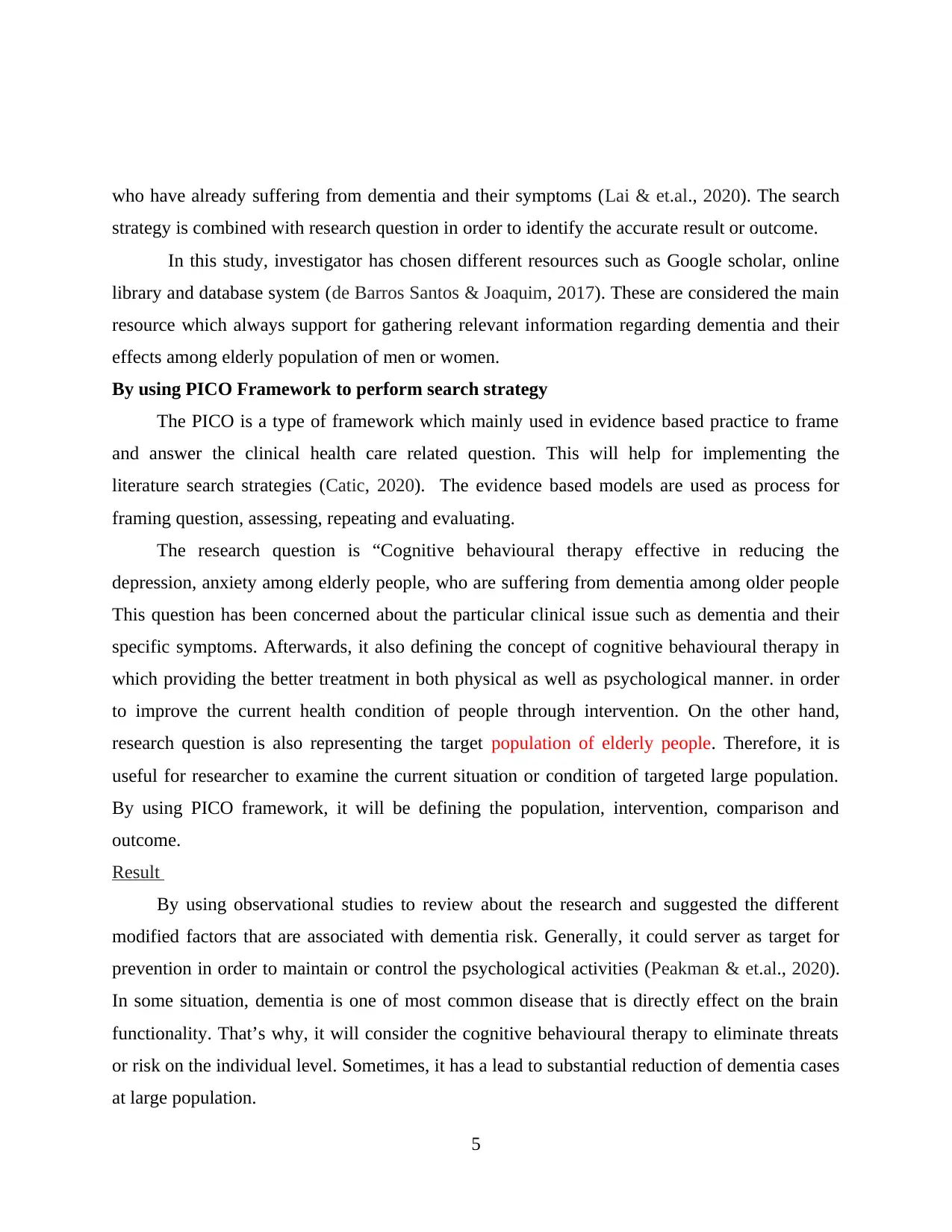
who have already suffering from dementia and their symptoms (Lai & et.al., 2020). The search
strategy is combined with research question in order to identify the accurate result or outcome.
In this study, investigator has chosen different resources such as Google scholar, online
library and database system (de Barros Santos & Joaquim, 2017). These are considered the main
resource which always support for gathering relevant information regarding dementia and their
effects among elderly population of men or women.
By using PICO Framework to perform search strategy
The PICO is a type of framework which mainly used in evidence based practice to frame
and answer the clinical health care related question. This will help for implementing the
literature search strategies (Catic, 2020). The evidence based models are used as process for
framing question, assessing, repeating and evaluating.
The research question is “Cognitive behavioural therapy effective in reducing the
depression, anxiety among elderly people, who are suffering from dementia among older people
This question has been concerned about the particular clinical issue such as dementia and their
specific symptoms. Afterwards, it also defining the concept of cognitive behavioural therapy in
which providing the better treatment in both physical as well as psychological manner. in order
to improve the current health condition of people through intervention. On the other hand,
research question is also representing the target population of elderly people. Therefore, it is
useful for researcher to examine the current situation or condition of targeted large population.
By using PICO framework, it will be defining the population, intervention, comparison and
outcome.
Result
By using observational studies to review about the research and suggested the different
modified factors that are associated with dementia risk. Generally, it could server as target for
prevention in order to maintain or control the psychological activities (Peakman & et.al., 2020).
In some situation, dementia is one of most common disease that is directly effect on the brain
functionality. That’s why, it will consider the cognitive behavioural therapy to eliminate threats
or risk on the individual level. Sometimes, it has a lead to substantial reduction of dementia cases
at large population.
5
strategy is combined with research question in order to identify the accurate result or outcome.
In this study, investigator has chosen different resources such as Google scholar, online
library and database system (de Barros Santos & Joaquim, 2017). These are considered the main
resource which always support for gathering relevant information regarding dementia and their
effects among elderly population of men or women.
By using PICO Framework to perform search strategy
The PICO is a type of framework which mainly used in evidence based practice to frame
and answer the clinical health care related question. This will help for implementing the
literature search strategies (Catic, 2020). The evidence based models are used as process for
framing question, assessing, repeating and evaluating.
The research question is “Cognitive behavioural therapy effective in reducing the
depression, anxiety among elderly people, who are suffering from dementia among older people
This question has been concerned about the particular clinical issue such as dementia and their
specific symptoms. Afterwards, it also defining the concept of cognitive behavioural therapy in
which providing the better treatment in both physical as well as psychological manner. in order
to improve the current health condition of people through intervention. On the other hand,
research question is also representing the target population of elderly people. Therefore, it is
useful for researcher to examine the current situation or condition of targeted large population.
By using PICO framework, it will be defining the population, intervention, comparison and
outcome.
Result
By using observational studies to review about the research and suggested the different
modified factors that are associated with dementia risk. Generally, it could server as target for
prevention in order to maintain or control the psychological activities (Peakman & et.al., 2020).
In some situation, dementia is one of most common disease that is directly effect on the brain
functionality. That’s why, it will consider the cognitive behavioural therapy to eliminate threats
or risk on the individual level. Sometimes, it has a lead to substantial reduction of dementia cases
at large population.
5
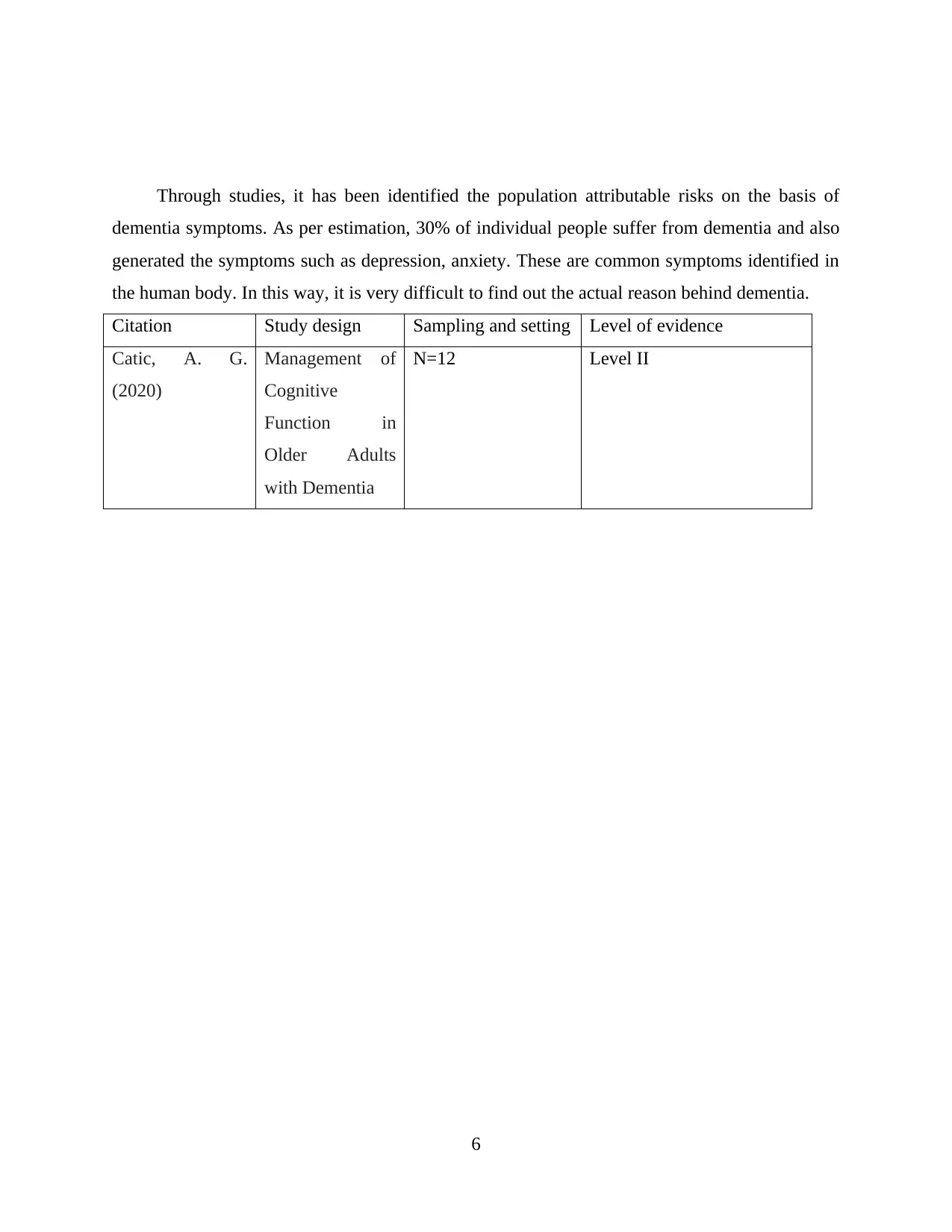
Through studies, it has been identified the population attributable risks on the basis of
dementia symptoms. As per estimation, 30% of individual people suffer from dementia and also
generated the symptoms such as depression, anxiety. These are common symptoms identified in
the human body. In this way, it is very difficult to find out the actual reason behind dementia.
Citation Study design Sampling and setting Level of evidence
Catic, A. G.
(2020)
Management of
Cognitive
Function in
Older Adults
with Dementia
N=12 Level II
6
dementia symptoms. As per estimation, 30% of individual people suffer from dementia and also
generated the symptoms such as depression, anxiety. These are common symptoms identified in
the human body. In this way, it is very difficult to find out the actual reason behind dementia.
Citation Study design Sampling and setting Level of evidence
Catic, A. G.
(2020)
Management of
Cognitive
Function in
Older Adults
with Dementia
N=12 Level II
6
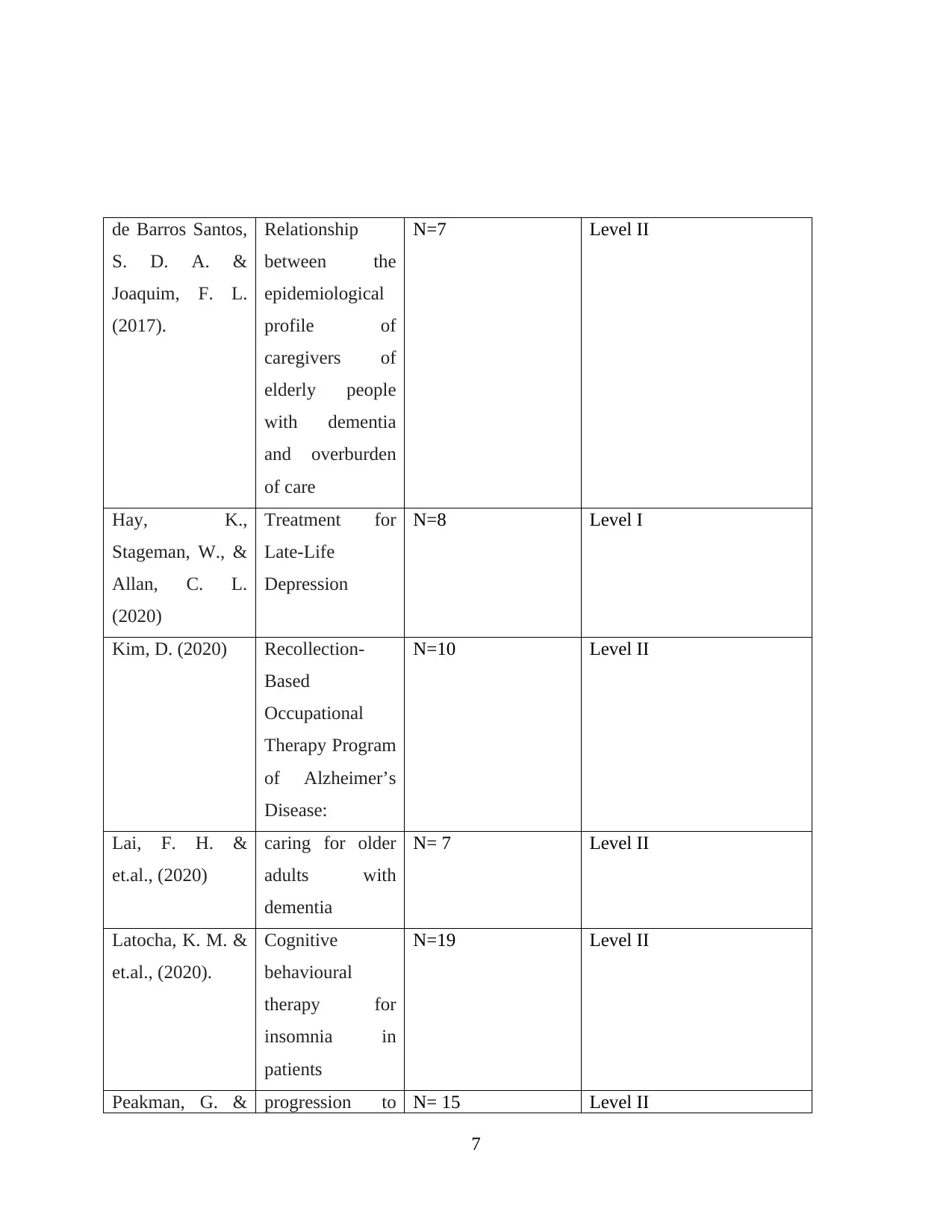
de Barros Santos,
S. D. A. &
Joaquim, F. L.
(2017).
Relationship
between the
epidemiological
profile of
caregivers of
elderly people
with dementia
and overburden
of care
N=7 Level II
Hay, K.,
Stageman, W., &
Allan, C. L.
(2020)
Treatment for
Late-Life
Depression
N=8 Level I
Kim, D. (2020) Recollection-
Based
Occupational
Therapy Program
of Alzheimer’s
Disease:
N=10 Level II
Lai, F. H. &
et.al., (2020)
caring for older
adults with
dementia
N= 7 Level II
Latocha, K. M. &
et.al., (2020).
Cognitive
behavioural
therapy for
insomnia in
patients
N=19 Level II
Peakman, G. & progression to N= 15 Level II
7
S. D. A. &
Joaquim, F. L.
(2017).
Relationship
between the
epidemiological
profile of
caregivers of
elderly people
with dementia
and overburden
of care
N=7 Level II
Hay, K.,
Stageman, W., &
Allan, C. L.
(2020)
Treatment for
Late-Life
Depression
N=8 Level I
Kim, D. (2020) Recollection-
Based
Occupational
Therapy Program
of Alzheimer’s
Disease:
N=10 Level II
Lai, F. H. &
et.al., (2020)
caring for older
adults with
dementia
N= 7 Level II
Latocha, K. M. &
et.al., (2020).
Cognitive
behavioural
therapy for
insomnia in
patients
N=19 Level II
Peakman, G. & progression to N= 15 Level II
7
Paraphrase This Document
Need a fresh take? Get an instant paraphrase of this document with our AI Paraphraser
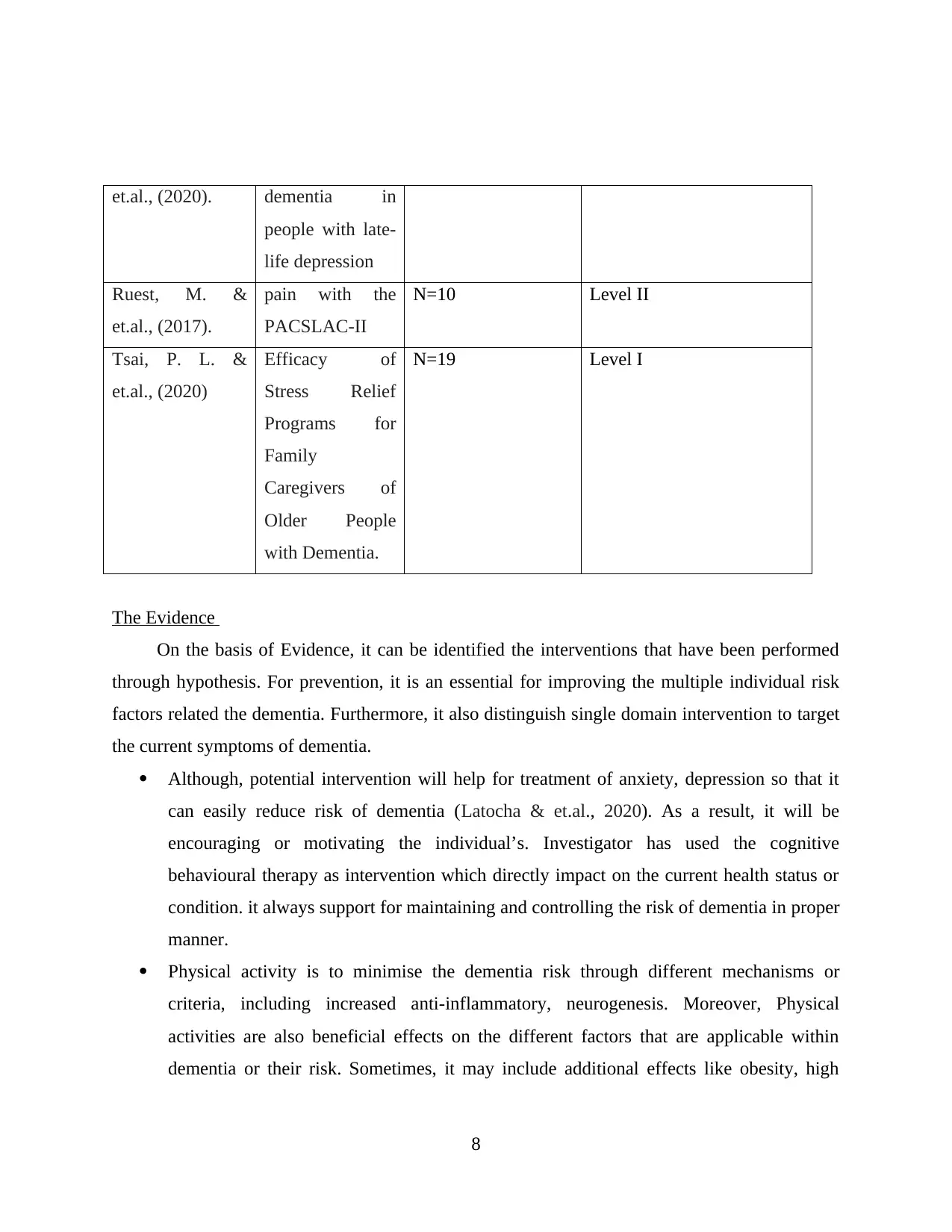
et.al., (2020). dementia in
people with late-
life depression
Ruest, M. &
et.al., (2017).
pain with the
PACSLAC-II
N=10 Level II
Tsai, P. L. &
et.al., (2020)
Efficacy of
Stress Relief
Programs for
Family
Caregivers of
Older People
with Dementia.
N=19 Level I
The Evidence
On the basis of Evidence, it can be identified the interventions that have been performed
through hypothesis. For prevention, it is an essential for improving the multiple individual risk
factors related the dementia. Furthermore, it also distinguish single domain intervention to target
the current symptoms of dementia.
Although, potential intervention will help for treatment of anxiety, depression so that it
can easily reduce risk of dementia (Latocha & et.al., 2020). As a result, it will be
encouraging or motivating the individual’s. Investigator has used the cognitive
behavioural therapy as intervention which directly impact on the current health status or
condition. it always support for maintaining and controlling the risk of dementia in proper
manner.
Physical activity is to minimise the dementia risk through different mechanisms or
criteria, including increased anti-inflammatory, neurogenesis. Moreover, Physical
activities are also beneficial effects on the different factors that are applicable within
dementia or their risk. Sometimes, it may include additional effects like obesity, high
8
people with late-
life depression
Ruest, M. &
et.al., (2017).
pain with the
PACSLAC-II
N=10 Level II
Tsai, P. L. &
et.al., (2020)
Efficacy of
Stress Relief
Programs for
Family
Caregivers of
Older People
with Dementia.
N=19 Level I
The Evidence
On the basis of Evidence, it can be identified the interventions that have been performed
through hypothesis. For prevention, it is an essential for improving the multiple individual risk
factors related the dementia. Furthermore, it also distinguish single domain intervention to target
the current symptoms of dementia.
Although, potential intervention will help for treatment of anxiety, depression so that it
can easily reduce risk of dementia (Latocha & et.al., 2020). As a result, it will be
encouraging or motivating the individual’s. Investigator has used the cognitive
behavioural therapy as intervention which directly impact on the current health status or
condition. it always support for maintaining and controlling the risk of dementia in proper
manner.
Physical activity is to minimise the dementia risk through different mechanisms or
criteria, including increased anti-inflammatory, neurogenesis. Moreover, Physical
activities are also beneficial effects on the different factors that are applicable within
dementia or their risk. Sometimes, it may include additional effects like obesity, high
8
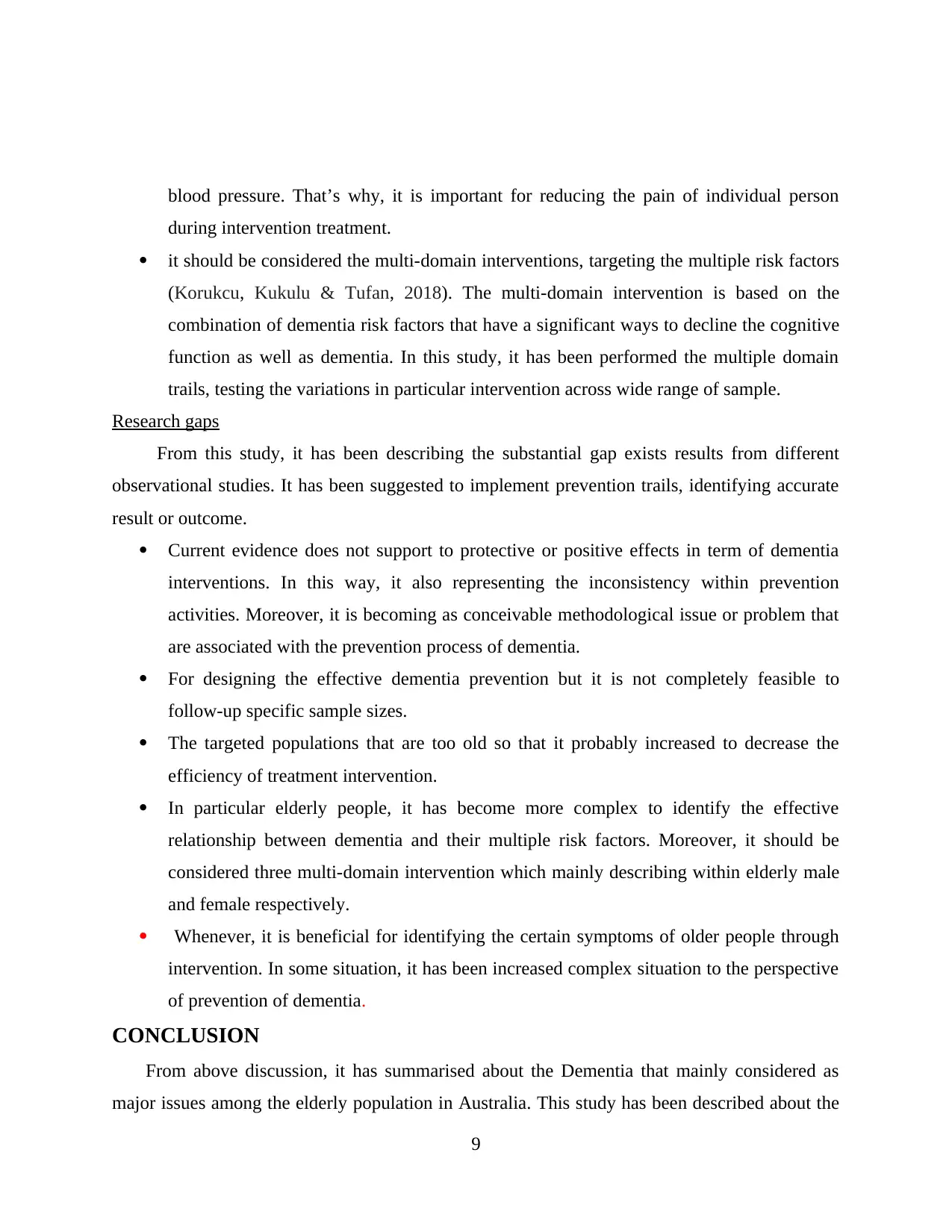
blood pressure. That’s why, it is important for reducing the pain of individual person
during intervention treatment.
it should be considered the multi-domain interventions, targeting the multiple risk factors
(Korukcu, Kukulu & Tufan, 2018). The multi-domain intervention is based on the
combination of dementia risk factors that have a significant ways to decline the cognitive
function as well as dementia. In this study, it has been performed the multiple domain
trails, testing the variations in particular intervention across wide range of sample.
Research gaps
From this study, it has been describing the substantial gap exists results from different
observational studies. It has been suggested to implement prevention trails, identifying accurate
result or outcome.
Current evidence does not support to protective or positive effects in term of dementia
interventions. In this way, it also representing the inconsistency within prevention
activities. Moreover, it is becoming as conceivable methodological issue or problem that
are associated with the prevention process of dementia.
For designing the effective dementia prevention but it is not completely feasible to
follow-up specific sample sizes.
The targeted populations that are too old so that it probably increased to decrease the
efficiency of treatment intervention.
In particular elderly people, it has become more complex to identify the effective
relationship between dementia and their multiple risk factors. Moreover, it should be
considered three multi-domain intervention which mainly describing within elderly male
and female respectively.
Whenever, it is beneficial for identifying the certain symptoms of older people through
intervention. In some situation, it has been increased complex situation to the perspective
of prevention of dementia.
CONCLUSION
From above discussion, it has summarised about the Dementia that mainly considered as
major issues among the elderly population in Australia. This study has been described about the
9
during intervention treatment.
it should be considered the multi-domain interventions, targeting the multiple risk factors
(Korukcu, Kukulu & Tufan, 2018). The multi-domain intervention is based on the
combination of dementia risk factors that have a significant ways to decline the cognitive
function as well as dementia. In this study, it has been performed the multiple domain
trails, testing the variations in particular intervention across wide range of sample.
Research gaps
From this study, it has been describing the substantial gap exists results from different
observational studies. It has been suggested to implement prevention trails, identifying accurate
result or outcome.
Current evidence does not support to protective or positive effects in term of dementia
interventions. In this way, it also representing the inconsistency within prevention
activities. Moreover, it is becoming as conceivable methodological issue or problem that
are associated with the prevention process of dementia.
For designing the effective dementia prevention but it is not completely feasible to
follow-up specific sample sizes.
The targeted populations that are too old so that it probably increased to decrease the
efficiency of treatment intervention.
In particular elderly people, it has become more complex to identify the effective
relationship between dementia and their multiple risk factors. Moreover, it should be
considered three multi-domain intervention which mainly describing within elderly male
and female respectively.
Whenever, it is beneficial for identifying the certain symptoms of older people through
intervention. In some situation, it has been increased complex situation to the perspective
of prevention of dementia.
CONCLUSION
From above discussion, it has summarised about the Dementia that mainly considered as
major issues among the elderly population in Australia. This study has been described about the
9
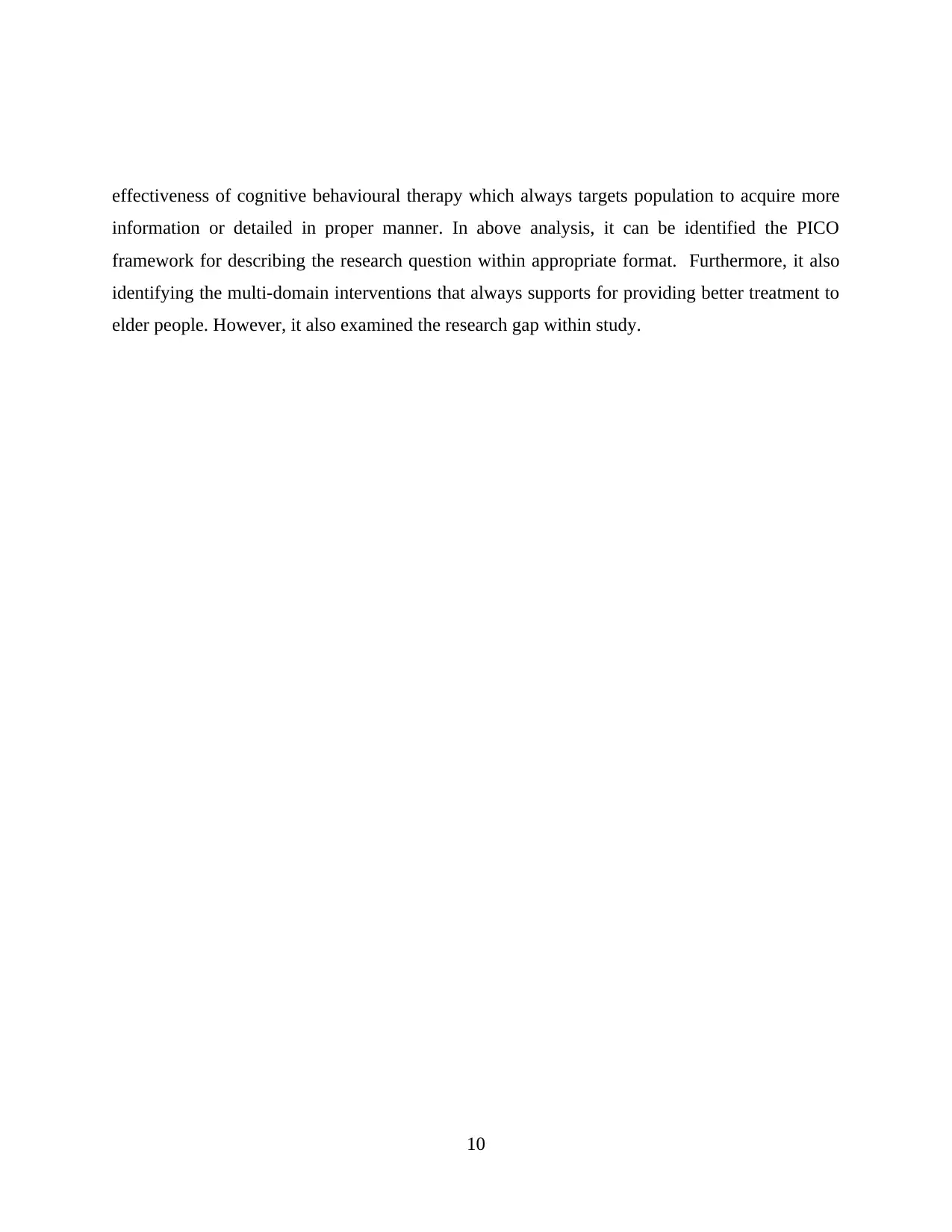
effectiveness of cognitive behavioural therapy which always targets population to acquire more
information or detailed in proper manner. In above analysis, it can be identified the PICO
framework for describing the research question within appropriate format. Furthermore, it also
identifying the multi-domain interventions that always supports for providing better treatment to
elder people. However, it also examined the research gap within study.
10
information or detailed in proper manner. In above analysis, it can be identified the PICO
framework for describing the research question within appropriate format. Furthermore, it also
identifying the multi-domain interventions that always supports for providing better treatment to
elder people. However, it also examined the research gap within study.
10
Secure Best Marks with AI Grader
Need help grading? Try our AI Grader for instant feedback on your assignments.
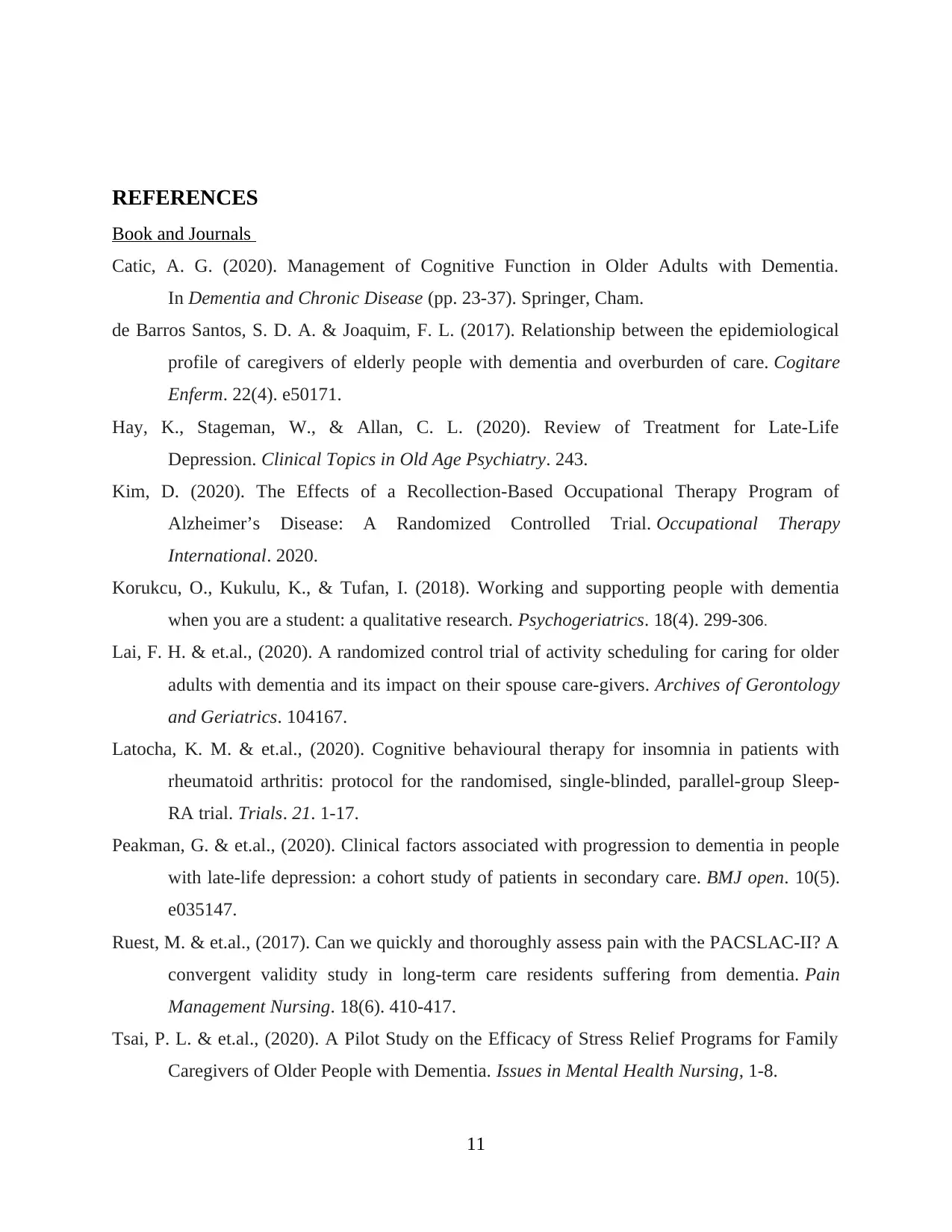
REFERENCES
Book and Journals
Catic, A. G. (2020). Management of Cognitive Function in Older Adults with Dementia.
In Dementia and Chronic Disease (pp. 23-37). Springer, Cham.
de Barros Santos, S. D. A. & Joaquim, F. L. (2017). Relationship between the epidemiological
profile of caregivers of elderly people with dementia and overburden of care. Cogitare
Enferm. 22(4). e50171.
Hay, K., Stageman, W., & Allan, C. L. (2020). Review of Treatment for Late-Life
Depression. Clinical Topics in Old Age Psychiatry. 243.
Kim, D. (2020). The Effects of a Recollection-Based Occupational Therapy Program of
Alzheimer’s Disease: A Randomized Controlled Trial. Occupational Therapy
International. 2020.
Korukcu, O., Kukulu, K., & Tufan, I. (2018). Working and supporting people with dementia
when you are a student: a qualitative research. Psychogeriatrics. 18(4). 299-306.
Lai, F. H. & et.al., (2020). A randomized control trial of activity scheduling for caring for older
adults with dementia and its impact on their spouse care-givers. Archives of Gerontology
and Geriatrics. 104167.
Latocha, K. M. & et.al., (2020). Cognitive behavioural therapy for insomnia in patients with
rheumatoid arthritis: protocol for the randomised, single-blinded, parallel-group Sleep-
RA trial. Trials. 21. 1-17.
Peakman, G. & et.al., (2020). Clinical factors associated with progression to dementia in people
with late-life depression: a cohort study of patients in secondary care. BMJ open. 10(5).
e035147.
Ruest, M. & et.al., (2017). Can we quickly and thoroughly assess pain with the PACSLAC-II? A
convergent validity study in long-term care residents suffering from dementia. Pain
Management Nursing. 18(6). 410-417.
Tsai, P. L. & et.al., (2020). A Pilot Study on the Efficacy of Stress Relief Programs for Family
Caregivers of Older People with Dementia. Issues in Mental Health Nursing, 1-8.
11
Book and Journals
Catic, A. G. (2020). Management of Cognitive Function in Older Adults with Dementia.
In Dementia and Chronic Disease (pp. 23-37). Springer, Cham.
de Barros Santos, S. D. A. & Joaquim, F. L. (2017). Relationship between the epidemiological
profile of caregivers of elderly people with dementia and overburden of care. Cogitare
Enferm. 22(4). e50171.
Hay, K., Stageman, W., & Allan, C. L. (2020). Review of Treatment for Late-Life
Depression. Clinical Topics in Old Age Psychiatry. 243.
Kim, D. (2020). The Effects of a Recollection-Based Occupational Therapy Program of
Alzheimer’s Disease: A Randomized Controlled Trial. Occupational Therapy
International. 2020.
Korukcu, O., Kukulu, K., & Tufan, I. (2018). Working and supporting people with dementia
when you are a student: a qualitative research. Psychogeriatrics. 18(4). 299-306.
Lai, F. H. & et.al., (2020). A randomized control trial of activity scheduling for caring for older
adults with dementia and its impact on their spouse care-givers. Archives of Gerontology
and Geriatrics. 104167.
Latocha, K. M. & et.al., (2020). Cognitive behavioural therapy for insomnia in patients with
rheumatoid arthritis: protocol for the randomised, single-blinded, parallel-group Sleep-
RA trial. Trials. 21. 1-17.
Peakman, G. & et.al., (2020). Clinical factors associated with progression to dementia in people
with late-life depression: a cohort study of patients in secondary care. BMJ open. 10(5).
e035147.
Ruest, M. & et.al., (2017). Can we quickly and thoroughly assess pain with the PACSLAC-II? A
convergent validity study in long-term care residents suffering from dementia. Pain
Management Nursing. 18(6). 410-417.
Tsai, P. L. & et.al., (2020). A Pilot Study on the Efficacy of Stress Relief Programs for Family
Caregivers of Older People with Dementia. Issues in Mental Health Nursing, 1-8.
11
1 out of 11
Related Documents
Your All-in-One AI-Powered Toolkit for Academic Success.
+13062052269
info@desklib.com
Available 24*7 on WhatsApp / Email
![[object Object]](/_next/static/media/star-bottom.7253800d.svg)
Unlock your academic potential
© 2024 | Zucol Services PVT LTD | All rights reserved.





